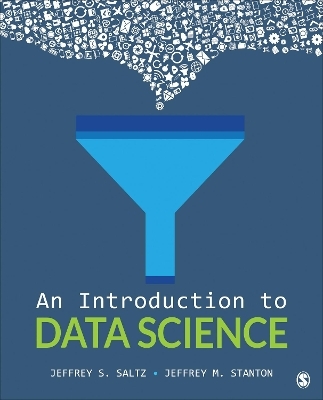
An Introduction to Data Science
SAGE Publications Inc (Verlag)
978-1-5063-7753-7 (ISBN)
An Introduction to Data Science is an easy-to-read, gentle introduction for advanced undergraduate, and graduate students coming from a wide range of backgrounds into the world of data science. After introducing the basic concepts of data science, the book builds on these foundations to explain data science techniques using the R programming language and RStudio (R) from the ground up. Short chapters allow instructors to group concepts together for a semester course and provide students with manageable amounts of information for each concept. By taking students systematically through the R programming environment, the book takes the fear out of data science and familiarizes students with the environment so they can be successful when performing advanced functions.
The authors cover statistics from a conceptual standpoint, focusing on how to use and interpret statistics, rather than the maths behind the statistics. This text then demonstrates how to use data effectively and efficiently to construct models, predict outcomes, visualize data, and make decisions.
Ancillaries
Accompanying digital resources provide code and datasets for instructors and learners to perform a wide range of data science tasks.
Jeffrey S. Saltz is currently an Associate Professor at Syracuse University, in the School of Information Studies. His research and teaching focus on helping organizations leverage information technology and data for competitive advantage. Specifically, Jeff's current research focuses on the socio-technical aspects of data science projects, such as how to coordinate and manage data science teams. In order to stay connected to the "real world", Jeff consults with clients ranging from professional football teams to Fortune 500 organizations. Prior to becoming a professor, Jeff's 20+ years of industry experience focused on leveraging emerging technologies and data analytics to deliver innovative business solutions. In his last corporate role, at JPMorgan Chase, he reported to the firm's Chief Information Officer and drove technology innovation across the organization. Jeff also held several other key technology management positions at the company, including CTO and Chief Information Architect. Jeff has also served as chief technology officer and principal investor at Goldman Sachs, where he invested and helped incubate technology start-ups. He started his career as a programmer, project leader and consulting engineer with Digital Equipment Corp. Jeff holds a B.S. degree in computer science from Cornell University, an M.B.A. from The Wharton School at the University of Pennsylvania and a Ph.D. in Information Systems from the New Jersey Institute of Technology.
Jeffrey M. Stanton, Ph.D. (University of Connecticut, 1997) is Associate Provost of Academic Affairs and Professor of Information Studies at Syracuse University. Dr. Stanton's research focuses on organizational behavior and technology. He is the author of Information Nation: Educating the Next Generation of Information Professionals (2010), with Dr. Indira Guzman and Dr. Kathryn Stam. Stanton has also published many scholarly articles in peer-reviewed behavioral science journals, such as the Journal of Applied Psychology, Personnel Psychology, and Human Performance. His articles also appear in Journal of Computational Science Education, Computers and Security, Communications of the ACM, Computers in Human Behavior, the International Journal of Human-Computer Interaction, Information Technology and People, the Journal of Information Systems Education, the Journal of Digital Information, Surveillance and Society, and Behaviour & Information Technology. He also has published numerous book chapters on data science, privacy, research methods, and program evaluation. Dr. Stanton's methodological expertise is in psychometrics with published works on the measurement of job satisfaction and job stress. Dr. Stanton's research has been supported through 18 grants and supplements including the National Science Foundation's CAREER award.
Preface
About the Authors
Introduction: Data Science, Many Skills
What Is Data Science?
The Steps in Doing Data Science
The Skills Needed to Do Data Science
Chapter 1 * About Data
Storing Data-Using Bits and Bytes
Combining Bytes Into Larger Structures
Creating a Data Set in R
Chapter 2 * Identifying Data Problems
Talking to Subject Matter Experts
Looking for the Exception
Exploring Risk and Uncertainty
Chapter 3 * Getting Started With R
Installing R
Using R
Creating and Using Vectors
Chapter 4 * Follow the Data
Understand Existing Data Sources
Exploring Data Models
Chapter 5 * Rows and Columns
Creating Dataframes
Exploring Dataframes
Accessing Columns in a Dataframe
Chapter 6 * Data Munging
Reading a CSV Text File
Removing Rows and Columns
Renaming Rows and Columns
Cleaning Up the Elements
Sorting Dataframes
Chapter 7 * Onward With RStudio (R)
Using an Integrated Development Environment
Installing RStudio
Creating R Scripts
Chapter 8 * What's My Function?
Why Create and Use Functions?
Creating Functions in R
Testing Functions
Installing a Package to Access a Function
Chapter 9 * Beer, Farms, and Peas and the Use of Statistics
Historical Perspective
Sampling a Population
Understanding Descriptive Statistics
Using Descriptive Statistics
Using Histograms to Understand a Distribution
Normal Distributions
Chapter 10 * Sample in a Jar
Sampling in R
Repeating Our Sampling
Law of Large Numbers and the Central Limit Theorem
Comparing Two Samples
Chapter 11 * Storage Wars
Importing Data Using RStudio
Accessing Excel Data
Accessing a Database
Comparing SQL and R for Accessing a Data Set
Accessing JSON Data
Chapter 12 * Pictures Versus Numbers
A Visualization Overview
Basic Plots in R
Using ggplot2
More Advanced ggplot2 Visualizations
Chapter 13 * Map Mashup
Creating Map Visualizations With ggplot2
Showing Points on a Map
A Map Visualization Example
Chapter 14 * Word Perfect
Reading in Text Files
Using the Text Mining Package
Creating Word Clouds
Chapter 15 * Happy Words?
Sentiment Analysis
Other Uses of Text Mining
Chapter 16 * Lining Up Our Models
What Is a Model?
Linear Modeling
An Example-Car Maintenance
Chapter 17 * Hi Ho, Hi Ho-Data Mining We Go
Data Mining Overview
Association Rules Data
Association Rules Mining
Exploring How the Association Rules Algorithm Works
Chapter 18 * What's Your Vector, Victor?
Supervised and Unsupervised Learning
Supervised Learning via Support Vector Machines
Support Vector Machines in R
Chapter 19 * Shiny (R) Web Apps
Creating Web Applications in R
Deploying the Application
Chapter 20 * Big Data? Big Deal!
What Is Big Data?
The Tools for Big Data
Index
| Erscheinungsdatum | 31.01.2018 |
|---|---|
| Verlagsort | Thousand Oaks |
| Sprache | englisch |
| Maße | 187 x 231 mm |
| Gewicht | 500 g |
| Themenwelt | Mathematik / Informatik ► Informatik ► Datenbanken |
| Mathematik / Informatik ► Informatik ► Netzwerke | |
| Informatik ► Weitere Themen ► Hardware | |
| Sozialwissenschaften ► Soziologie ► Empirische Sozialforschung | |
| Wirtschaft ► Betriebswirtschaft / Management ► Unternehmensführung / Management | |
| ISBN-10 | 1-5063-7753-X / 150637753X |
| ISBN-13 | 978-1-5063-7753-7 / 9781506377537 |
| Zustand | Neuware |
| Informationen gemäß Produktsicherheitsverordnung (GPSR) | |
| Haben Sie eine Frage zum Produkt? |
aus dem Bereich


